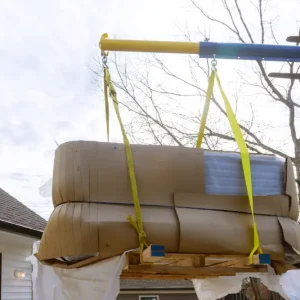Need to move a storage shed? This article cuts through the confusion, offering you the essential information on “how to move a storage shed: what you need to know”. We look at the shed’s stability, size, and location access, detail the tools required, and discuss when to call in professionals. Expect no-nonsense advice geared towards making your shed’s transition smooth and secure.

Key Takeaways
- Examine your shed’s structural integrity, size, and accessibility before the move to ensure it can handle the transition; if necessary, reinforce it for extra stability.
- Have the necessary equipment, such as lumber skids, jacks, dollies, trailers, and supports, ready to facilitate the move; empty the shed and disconnect it from its foundation.
- Consider hiring professionals like Horizon Movers for their expertise in shed moves, saving you from a DIY headache and minimizing the risk of damage.
Assessing Your Storage Shed for Relocation
Before moving your storage shed, evaluating its feasibility is a necessary first step. This initial step is like preparing for a road trip – you wouldn’t hit the road without ensuring your vehicle is in top shape, right? The same goes for your shed. Assessing its structural stability, size, and accessibility will not only give you peace of mind but will also dictate the level of preparation required for a smooth transition.
We’ll explore these crucial areas to prepare your shed for the upcoming relocation.
Structural Stability
The integrity of your shed is paramount when considering relocation. Think of it as checking the roadworthiness of a car before a long trip. Examining your shed’s condition is essential for its ability to withstand the relocation without collapsing. If you find signs of wear or weakness, your shed might be more susceptible to damage during the move.
Adding reinforcements to your shed, akin to equipping your walls with seatbelts, can prevent structural collapse. Fortify your shed by nailing or screwing boards across each wall and creating an X pattern on the floor, connecting to the studs for maximum stability. This added support will make your shed as sturdy as a fortress, ready to withstand the rigors of relocation.
Size Considerations
Size does matter when it comes to moving your shed. It’s like trying to fit a square peg in a round hole; you need to know what you’re working with to find the best solution. Small sheds, typically those 8×12 feet or less, can often be moved in one piece, making them portable and less of a headache to relocate. However, for those with larger sheds, you may need to consider disassembly to ensure a smooth move.
If your shed is a larger structure or site constraints exist, disassembling it into manageable parts can be your best option. It’s a bit like a puzzle, but you can reconstruct your shed perfectly at its new home with the right approach.
Accessibility
Imagine navigating a ship through a narrow canal; that’s akin to moving your storage shed if the accessibility conditions are less than ideal. It’s essential to examine the terrain, including verifying the ground’s evenness, lack of obstructions, and sufficient clearance around the shed for lifting equipment. And don’t forget about overhead hazards like power lines or unexpected sharp turns that could complicate the process. Additionally, consider the excess weight of the items stored inside the shed, as it may affect the moving process. Be sure to check for window and door openings requiring extra attention during the relocation.
A clear, accessible path, including proper door openings, simplifies the shed relocation process, much like preparing for a smooth sail.
Necessary Tools and Materials for Shed Moving
Moving a shed is akin to orchestrating a ballet of precise movements and sturdy supports. To pull off this feat, you’ll need an array of tools and materials that are up to the task. From the finesse of a thin-blade saw to the brute force of a bottle jack underneath, each tool plays a pivotal role in the relocation dance. So, when you’re ready to move a shed, make sure you have the right equipment on hand.
Consider the following steps when moving your shed:
- Lay down treated lumber skids beneath your shed to distribute its weight evenly, like a raft floating on a river.
- Use a jack to lift the shed off the ground.
- Slide a transport device underneath the shed, such as a dolly or trailer.
- Secure the shed to the transport device to ensure it stays in place during the move.
- Install additional supports, such as cross-braces for windows and doors, to keep the shed steady and unyielding during the move.
Following these steps, you can safely and effectively move your shed to a new location.
And let’s not forget the tracks – plywood sheets can serve as your stage, guiding your shed to its new location with grace and precision, while metal pipes can provide additional support if needed, especially with a sled underneath.
Preparing Your Shed for Movement
With your tools ready, the next step is to prepare your shed for relocation, like getting a plane ready for takeoff. Clearing the shed’s interior of all contents is a must to prevent any internal chaos during transport. Next, sever all ties to the foundation to ensure your shed can embark on its new journey.
And just as a pilot would scout out the perfect landing strip, ensure the new location is ready with a sturdy base to welcome your shed home. With these preparations in place, your storage shed will be ready to take flight to its new destination.
Enlisting Help from Horizon Movers and Climate Control Storage
Sometimes, a DIY approach might feel like a solo trek up Everest—daunting, to say the least. This is where Horizon Movers and Climate Control Storage come into the picture, offering a sherpa-like service for your shed relocation. With over two decades of experience moving delicate items, you can rest assured that your shed is in the hands of seasoned professionals who understand the ins and outs of a successful move.
Whether it’s a short-distance move or a long-distance transfer, Horizon Movers provides expertise and peace of mind, acting as a reliable guide through unfamiliar territory.

Expertise in Shed Moving
Engaging Horizon Movers’ professional services is akin to having an expert conductor guiding your orchestra. With a repertoire that spans over 25 years, their specialized services are music to the ears of those needing storage shed relocation. Their track record is a symphony of successful moves, each as meticulously planned and executed as a classical masterpiece.
Horizon Movers’ two decades of operation underscore their proven reliability. They ensure that your shed’s transition is as seamless as a well-rehearsed performance.
Stress-Free and Hassle-Free Moves
When it comes to moving, the thought alone can stir up a symphony of stress. But with Horizon Movers, you get to conduct a serene movement, free from the cacophony of moving woes. Their method of fully wrapping and protecting furniture wraps your concerns in layers of care and professionalism, much like a delicate instrument cradled in its case.
This unique approach ensures that your portable buildings, including your entire shed, an entire structure in itself, and all its components, arrive at the new shed site in pristine condition, ready to play their role in your life’s orchestra without missing a beat.
Positive Customer Reviews
The crescendo of Horizon Movers’ exceptional service is the chorus of over 200 five-star reviews singing their praises. Each review is a testament, a melody of satisfaction from customers who’ve experienced their efficiency, professionalism, and care firsthand.
Like a standing ovation, these reviews echo the sentiments of those who have entrusted their storage sheds to Horizon Movers, ensuring you that your moving experience will be nothing short of a grand finale, all at average prices.
Shed Moving Techniques
Relocating your shed can be achieved through various techniques, as diverse as the tools in a carpenter’s toolkit. Whether you’re lifting with jacks and rolling on pipes or enlisting heavy machinery for the task, each technique has its own rhythm and flow. And if orchestrating the move yourself sounds like conducting a symphony single-handedly, remember that Horizon Movers can step in to lead the performance, ensuring your shed’s relocation is a harmonious success.
Even if you choose a more hands-on approach, like using a flatbed trailer, securing your structure before transport is crucial. This approach ensures your shed’s journey is smooth. And should you decide to move the shed with a tractor, treat it with the care of a maestro handling his baton, navigating with precision and caution.
Securing and Reassembling Your Shed at Its New Location
Upon arrival at its new location, you need to reassemble your shed. For instance, if you referenced a map during the journey, use pre-move photographs to guide the reassembly. Rebuilding the shed with the aid of labels and a keen eye for detail will ensure each piece is accurately repositioned and securely fastened, perhaps even with upgraded hardware for added strength.
Inspect all sections during reassembly and replace any damaged parts during the move to maintain your shed’s structural integrity. Finally, just as you would after a long voyage, settle your shed on its new foundation, adjust for level, and ensure it is adequately supported and stable, ready for the next chapter in its storied existence.
Shed Moving Costs and Options
Relocating a shed requires not only physical effort but also financial considerations. The art of relocation can range from a DIY project to hiring professional movers like Horizon Movers, each with its own cost structure when considering a DIY move, factor in equipment and transportation costs, which can add up quickly. On the other hand, professional movers offer a range of services, from on-site relocations to long-distance moves, with costs varying based on the size and distance of the move.
Remember to consider potential additional expenses such as truck rentals, permits, and parking fees, which can influence the overall budget for your shed’s relocation. When making your decision, weigh the costs against the convenience and peace of mind that come with professional services and choose the option that harmonizes with your needs and financial situation.
Preventing Damage During the Shed Move
Preventing your shed from damage during relocation, akin to avoiding scratches on a cherished vinyl record, is crucial. To prevent any mishaps, plan your move for optimal weather conditions, avoiding the potential for slip-ups due to rain, mud, or bare earth.
Clear the path to your shed’s new location, ensuring it’s free from anything that might disrupt the move, much like clearing the stage before a performance. Reinforce your shed’s structure with additional supports, and wrap it up tightly with ratcheting tie-downs to keep it intact, similar to how you’d protect a fragile antique during transport.
As you roll your shed forward on pipes or secure it on a trailer, remain vigilant and adjust to maintain its integrity throughout the journey. By taking these precautionary steps, you can ensure your shed’s move is smooth and damage-free.
Summary
As our guide to moving a storage shed comes to a close, it’s clear that the process is much like a well-choreographed dance. From assessing your shed’s readiness for the journey to choosing the proper moving techniques and preparing for any potential hiccups along the way, each step is integral to the move’s success. Whether you decide to manage the move yourself or enlist the help of professionals like Horizon Movers and Climate Control Storage, remember that proper planning, preparation, and execution are the keys to a seamless transition. May the next chapter of your shed’s story be as stable and secure as its new foundation.
Frequently Asked Questions
Can I move a large shed by myself?
Moving a large shed alone can be challenging and require heavy machinery or professional help. Consider enlisting professional movers for larger sheds.
What tools will I need to move my shed?
You’ll need jacks, pallet jacks, a dolly, PVC tubes, nails, screws, plywood sheets, and reinforcements for the shed’s structure to ensure a successful move.
How can I ensure my shed won’t get damaged during the move?
To ensure your shed won’t get damaged during the move, plan for good weather, clear the path, reinforce its structure, and secure it tightly during transport. Continuous vigilance and adjustments are essential to maintain the shed’s integrity.
How much does it cost to move a shed?
A DIY shed move can cost between $100 and $500, while professional services usually range from $200 to $500 for local moves and up to $2 per mile for longer distances. You may also need to consider additional expenses like truck rentals and permits.
Is it better to move my shed or build a new one?
It’s best to compare the moving costs to the price of a new shed to see which option is more cost-effective. Consider factors like the shed’s size, weight, and the distance of the move.




